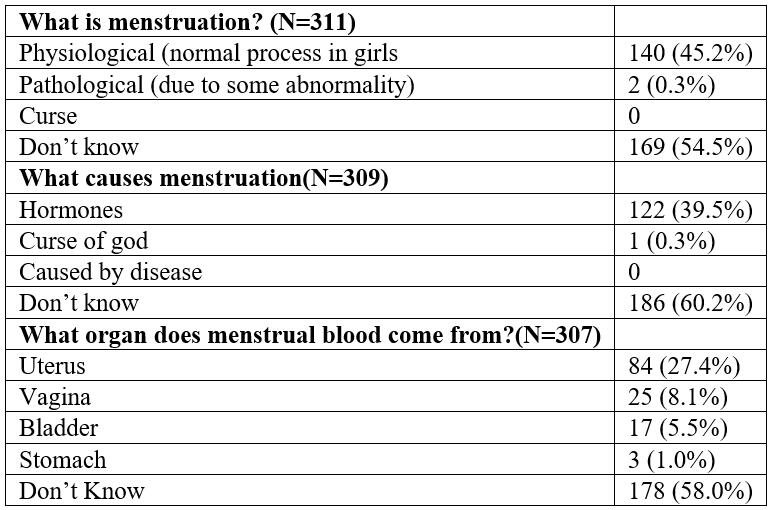Analysis of Knowledge of Menstruation, Hygiene Practices, and Perceptions in Adolescent Girls in India
Abstract
Introduction: Unsafe water, poor sanitation and inadequate hygiene affects many communities around the world. Without access to clean water, proper waste management, or knowledge of basic hygiene practices, the risk for disease is greatly increased. The menstrual cycle can be hard to manage without access to clean products. Additionally, poor knowledge can perpetuate unhygienic practices. Girls are often not taught about menstruation before it occurs leaving them with feelings of fear, disgust, and uncertainty.
Methods: This paper analyzes data from adolescent girls in both rural and urban communities in India concerning their knowledge, perceptions, and hygiene practices regarding menstruation. Results from pre and posttests indicate change in knowledge following an educational intervention.
Results: The knowledge and practices of adolescent Indian girls regarding menstrual hygiene were greatly lacking. In fact, 53.8% of girls did not know anything about menstruation prior to their first period. Overall, knowledge and practices improved significantly after the educational intervention.
Discussion and Conclusion: Education of girls on menstrual hygiene management is effective. The results of this study are generally consistent with other literature. Further educational and environmental interventions as well as research are needed.
References
Chothe, V., Jagdsih, K., Seabert, D., Asalar, M., Rakshe, S., Firke, A., et al. (2014). Students’ perceptions and doubts about menstruation in developing countries: A case study from India. Health Promotion Practice, 2014. https://doi.org/10.1177/1524839914525175
Dasgupta, A., & Sarkar, M. (2008). Menstrual Hygiene: How Hygienic is the Adolescent Girl? Indian Journal of Community Medicine: Official Publication of Indian Association of Preventive & Social Medicine, 2008. https://doi.org/10.4103/0970-0218.40872
Deo, D. S., & Ghattargi, C. H. (2005). Perceptions and practices regarding menstruation: A comparative study in urban and rural adolescent girls. Indian Journal of Community Medicine, 2005. Retrieved from http://medind.nic.in/iaj/t05/i1/iajt05i1p33.pdf
Garikipati, S., & Boudot, C. (2017). To pad or not to pad: Towards better sanitary care for women in Indian slums. Journal of International Development, 2017. https://doi.org/10.1002/jid.3266
Maji, S. (2016). A study on menstrual knowledge and practices among rural adolescent girls in Burdwan district, West Bengal. International Journal of Advanced Research, 2016. https://doi.org/10.21474/IJAR01/1558
Marni, S., Cherenack, E., Blake, S., Murat, S., & Burgers, L. (2015). WASH in schools empowers girls’ education: Proceedings of the menstrual hygiene management in schools virtual conference 2014, United Nations Children’s Fund and Columbia University, 2015. Retrieved from https://www.unicef.org/wash/schools/files/MHM_vConf_2014.pdf
Paria, B., Bhattacharyya, A., & Das, S. A. (2014). Comparative Study on Menstrual Hygiene Among Urban and Rural Adolescent Girls of West Bengal. J Family Med Prim Care, 2014. https://doi.org/10.4103/2249-4863.148131
Ramachandra, K. (2016). A study on knowledge and practices regarding menstrual hygiene among urban adolescent girls. International Journal of Contemporary Pediatrics, 2016. https://doi.org/10.18203/2349-3291.ijcp20160147
Shanbhag, D., Shilpa, R., D’Souza, N., Josephine, P., Singh, J., & Goud, B. R. (2012). Perceptions regarding menstruation and practices during menstrual cycle among high school going adolescent girls in resource limited settings around Bangalore city, Karnataka, India. International Journal of Collaborative Research on Internal Medicine and Public Health; 2012. Retrieved from http://ezproxy.liberty.edu/login?url=https://search.proquest.com/docview/1025744606?accountid=12085
Thakre, S. B., Thakre, S. S., Reddy, M., Rathi, N., Pathak, K., & Ughade, S. (2011). Menstrual hygiene: Knowledge and practice among adolescent school girls of Saoner, Nagpur district. J ClinDiagn Res, 2011. Retrieved from https://www.researchgate.net/profile/Suresh_Ughade/publication/267415792_Menstrual_Hygiene_Knowledge_and_Practice_among_Adolescent_School_Girls_of_Saoner_Nagpur_District/links/54c7c3620cf289f0cecdc3eb/Menstrual-Hygiene-Knowledge-and-Practice-among-Adolescent-School-Girls-of-Saoner-Nagpur-District.pdf
Van eijk, A. M., Sivakami, M., Thakkar, M., Bauman, A., Laserson, K., Coates, S., et al. (2016). Menstrual hygiene management among adolescent girls in India: A systematic review and meta-analysis. BMU Open, 2016. https://doi.org/10.1136/bmjopen-2015-010290


This work is licensed under a Creative Commons Attribution 4.0 International License.
Copyright for this article is retained by the author(s), with first publication rights granted to the journal.
This is an open-access article distributed under the terms and conditions of the Creative Commons Attribution license (http://creativecommons.org/licenses/by/4.0/).









1.png)














